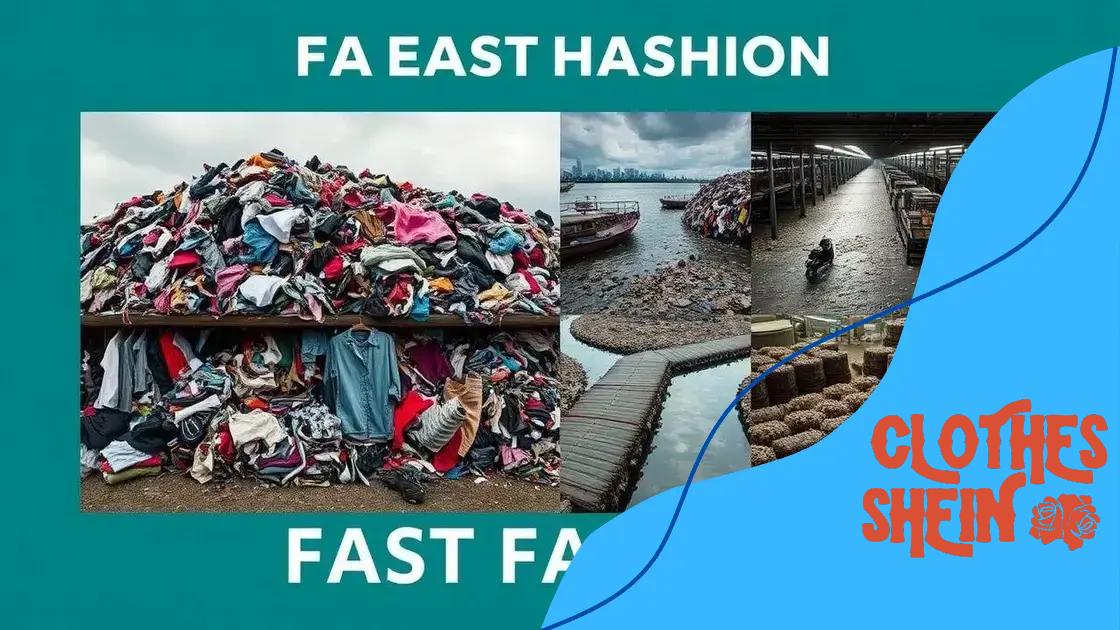Shein’s impact on global clothing markets

Shein’s impact on global clothing markets is marked by its fast fashion model, affordable pricing, and significant environmental concerns, influencing consumer behavior and prompting discussions on sustainability.
Shein’s impact on global clothing markets raises important questions about sustainability and consumer choices. Have you noticed how quickly trends shift thanks to this brand? Let’s dive into its influence on what we wear.
Understanding Shein’s business model
To truly grasp Shein’s business model, it’s essential to recognize how it has altered the landscape of fashion retail. Shein operates primarily online, leveraging technology to connect directly with consumers. This direct-to-consumer model allows for a faster response to trends, minimizing inventory risks and maximizing customer satisfaction.
Core Features of Shein’s Strategy
Several key elements contribute to Shein’s success in a competitive market:
- Rapid Trend Adaptation: Shein updates its inventory frequently, often introducing new styles multiple times a week.
- Low Pricing: By offering stylish clothing at affordable prices, Shein attracts a broad demographic, especially young shoppers.
- Social Media Engagement: Shein effectively uses platforms like Instagram and TikTok for marketing, creating buzz around their products.
- Data-Driven Decisions: The company utilizes data analytics to understand customer preferences, tailoring their offerings accordingly.
This strategy not only appeals to consumers but also enhances brand loyalty as shoppers return for the latest trendy items. Shein’s emphasis on affordability and quantity means they often outperform traditional retailers in terms of sales volume.
Moreover, Shein’s global reach is a significant advantage. With an extensive online presence across various countries, they can easily tap into diverse markets. This international strategy helps mitigate risks associated with economic fluctuations in individual markets.
The use of influencer collaborations has also bolstered Shein’s visibility. By partnering with social media influencers, the brand gains authentic exposure, aligning itself with fashion trends favored by young consumers. This collaborative approach has proven effective, driving traffic and generating buzz around their newest lines.
In summary, understanding Shein’s business model reveals why it has emerged as a dominant player in the global clothing market. The combination of a fast-paced inventory system, strategic pricing, and savvy digital marketing has propelled Shein to noteworthy heights in the fashion industry.
How Shein influences global fashion trends
Shein plays a significant role in shaping global fashion trends. Its influence is visible in the rapid changes consumers see in styles and preferences. The brand’s ability to adapt quickly to emerging trends sets it apart in the fashion industry.
Key Factors Behind Shein’s Influence
Several aspects contribute to how Shein influences fashion trends worldwide:
- Fast Fashion Model: Shein’s quick turnaround from design to retail helps it capture trends before they fade.
- Social Media Marketing: The brand effectively uses platforms like TikTok and Instagram to promote its styles and reach younger audiences.
- Collaborations with Influencers: By partnering with fashion influencers, Shein showcases its products and drives consumer interest.
- User-Generated Content: Encouraging customers to share their outfits on social media helps create a community around the brand.
Beyond just selling clothes, Shein affects what people want to wear. When a trend emerges, Shein often has similar items available within days, tapping into consumer desire for the latest looks. This speed not only excites shoppers but also encourages other fashion brands to respond more quickly to trends.
As Shein engages with its audience through vibrant marketing and targeted campaigns, it establishes a loyal customer base. Young consumers enjoy being part of a trend cycle, where they can wear the latest styles without breaking the bank.
The brand’s influence extends beyond its customer base. Many fashion brands and retailers monitor Shein’s collections to see what styles might gain traction, understanding that the company often sets trends rather than follows them. By analyzing social media and sales data, Shein identifies shifts in consumer preferences, enabling it to stay ahead of the competition.
In essence, Shein doesn’t just respond to trends; it actively shapes them. Through innovative marketing and a keen understanding of consumer behavior, the brand ensures its place at the forefront of the global fashion landscape.
The environmental impact of Shein’s fast fashion

Shein’s rapid rise in the fashion industry has raised concerns about the environmental impact of its fast fashion model. As a retailer known for quickly producing trendy clothing at low prices, the environmental consequences of this approach are significant.
Major Environmental Concerns
Several key issues highlight the negative effects of Shein’s production practices:
- Excessive Waste: Fast fashion leads to a high turnover of clothing, contributing to massive amounts of textile waste in landfills.
- Resource Intensity: The fast manufacturing processes demand large quantities of natural resources, from water used in fabric production to energy needed for transportation.
- Pesticide Use: The cotton farming necessary for many Shein products often relies on harmful pesticides, impacting both soil and water quality.
- Carbon Footprint: Shein’s global supply chain creates a substantial carbon footprint due to the transportation of goods across long distances.
Beyond these concerns, Shein’s quick production cycles encourage a throwaway culture. Shoppers often buy clothes that they wear only a few times, resulting in a cycle of consumption that lacks sustainability. The appealing prices and trendy designs can overshadow the long-term consequences of overconsumption.
Moreover, critics argue that Shein’s marketing strategies perpetuate the need for constant newness in fashion, pushing consumers to keep buying more. This continuous demand exacerbates environmental issues, leading to more production and waste.
Ultimately, while Shein offers affordability and style, its impact on the environment cannot be ignored. Understanding these effects can help consumers make more informed choices about their shopping habits. As more people become aware of the environmental costs, there is an increasing call for sustainable practices in the fashion industry.
Consumer attitudes toward Shein’s pricing
Consumer attitudes toward Shein’s pricing reflect a mix of excitement and skepticism. Many shoppers are drawn to the brand for its incredibly low prices, which allow them to purchase a vast array of trendy items without spending much.
Attraction to Affordability
The primary factor influencing consumer perceptions is the affordability of Shein’s products. Shoppers appreciate being able to buy multiple items without breaking their budgets. This value proposition resonates, especially with younger consumers who often seek budget-friendly options while still wanting to stay fashionable.
- Variety and Selection: Shein offers a wide range of styles and sizes, which attracts consumers looking for options that fit their personal tastes.
- Cyclic Discounts: Regular promotions and discounts encourage repeated visits, making it easy for consumers to justify additional purchases.
- Lower Risk: Low prices decrease the perceived risk of trying out new styles and trends.
While many consumers love the prices, some exhibit skepticism regarding the true cost of such low prices. Questions arise about the quality of materials and ethical implications behind production. Consumers are becoming more conscious of where their clothes come from and how they are made.
Additionally, a segment of shoppers expresses concern about the sustainability of fast fashion. Some are wary that buying cheap clothes contributes to a cycle of waste and environmental degradation, leading them to reconsider their shopping habits.
Despite these concerns, Shein successfully taps into the desire for affordability and trendiness. The brand’s pricing strategy remains effective, especially for those who prioritize style over sustainability. As consumers continue to navigate their values, Shein’s pricing will remain a key discussion point in the evolving fashion landscape.
Future prospects for Shein in the clothing market
The future prospects for Shein in the clothing market are intriguing as the brand continues to evolve. As a leader in fast fashion, Shein’s ability to adapt to changing consumer preferences will determine its long-term success.
Anticipated Trends
Several key trends likely will shape Shein’s path forward:
- Growing Demand for Sustainability: As more consumers prioritize eco-friendly products, Shein may need to implement sustainable practices to meet expectations.
- Digital Expansion: Expanding its online presence and utilizing innovative technology could enhance customer experiences and streamline operations.
- Global Market Growth: Shein’s expansion into new international markets presents opportunities for increased sales and brand awareness.
- Focus on Shopping Experience: Enhancing the shopping experience through personalized recommendations and user-friendly interfaces will be crucial in keeping consumers engaged.
In general, as shoppers become more aware of their choices, Shein may need to strike a balance between affordability and ethical responsibility. A shift towards truly sustainable practices will help build trust and loyalty among consumers who are increasingly conscious of the environmental impacts of their purchases.
Moreover, Shein’s strong social media presence will likely play a significant role in shaping its future. By continuing to leverage platforms like Instagram and TikTok for marketing, Shein can engage with its young audience effectively. Influencer collaborations can further boost visibility and align the brand with current trends.
If Shein successfully adapts to these expectations and continues its innovative marketing strategies, it stands to secure its place in the competitive clothing market. However, challenges such as increased scrutiny over sustainability and competition from emerging brands will test its resilience.
FAQ – Frequently Asked Questions about Shein’s Impact on the Clothing Market
What makes Shein popular among consumers?
Shein’s popularity stems from its affordable prices and trendy clothing options, appealing particularly to younger shoppers.
How does Shein affect the environment?
Shein’s fast fashion model contributes to excessive textile waste and environmental concerns due to its rapid production and consumption rates.
What challenges does Shein face in the future?
As consumers grow more aware of sustainability issues, Shein faces challenges related to adapting its practices to meet ethical and environmental expectations.
How can Shein maintain its competitive edge?
By continuing to innovate its marketing strategies, such as leveraging social media and influencer partnerships, while also addressing sustainability concerns.





